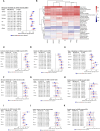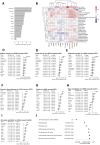This is a preprint.
Associations of proteomic age with mortality and incident chronic diseases in the European Prospective Investigation into Cancer and Nutrition (EPIC)
- PMID: 40709259
- PMCID: PMC12288520
- DOI: 10.21203/rs.3.rs-7087230/v1
Associations of proteomic age with mortality and incident chronic diseases in the European Prospective Investigation into Cancer and Nutrition (EPIC)
Abstract
Assessment of biological ageing using proteomic clocks may enhance risk prediction and elucidate the molecular links between ageing and chronic diseases. Within a pre-diagnostic cohort of 17,473 Europeans with up to 28 years of follow-up, we examined associations of plasma SomaScan-based proteomic clocks, including organ-specific clocks, with 24 incident chronic diseases, all-cause mortality, and lifestyle risk factors. Global proteomic age gap (a composite biological age acceleration score combining previously published clocks) showed the strongest positive association of all tested clocks with all-cause mortality. Accelerated proteomic ageing was significantly associated with smoking, alcohol consumption, physical inactivity, and higher risk of cardiovascular diseases, dementia, and liver, upper aero-digestive tract, lung, and kidney cancers. Some organ-specific cancers were more strongly associated with their respective organ-specific age gaps. Mortality prediction by proteomic clocks was comparable in performance to classical lifestyle risk factors. In summary, proteomic clocks appear promising biomarkers of generalized age-related disease risk.
Keywords: Aging; SomaLogic; aptamers; biological age; biological clocks; cancer; cardiovascular disease; diabetes; neurodegeneration; proteomics; risk factors; risk prediction.
Conflict of interest statement
Additional Declarations: There is NO Competing Interest.
Figures






Similar articles
-
Development, characterization, and replication of proteomic aging clocks: Analysis of 2 population-based cohorts.PLoS Med. 2024 Sep 24;21(9):e1004464. doi: 10.1371/journal.pmed.1004464. eCollection 2024 Sep. PLoS Med. 2024. PMID: 39316596 Free PMC article.
-
Development and Characterization of Proteomic Aging Clocks in the Atherosclerosis Risk in Communities (ARIC) Study.medRxiv [Preprint]. 2023 Sep 8:2023.09.06.23295174. doi: 10.1101/2023.09.06.23295174. medRxiv. 2023. Update in: PLoS Med. 2024 Sep 24;21(9):e1004464. doi: 10.1371/journal.pmed.1004464. PMID: 37732184 Free PMC article. Updated. Preprint.
-
Organ-specific proteomic aging and cognitive performance: Implications for risk prediction of Alzheimer's disease and related dementias in older adults.J Prev Alzheimers Dis. 2025 Jul 22:100274. doi: 10.1016/j.tjpad.2025.100274. Online ahead of print. J Prev Alzheimers Dis. 2025. PMID: 40701901
-
Systemic pharmacological treatments for chronic plaque psoriasis: a network meta-analysis.Cochrane Database Syst Rev. 2017 Dec 22;12(12):CD011535. doi: 10.1002/14651858.CD011535.pub2. Cochrane Database Syst Rev. 2017. Update in: Cochrane Database Syst Rev. 2020 Jan 9;1:CD011535. doi: 10.1002/14651858.CD011535.pub3. PMID: 29271481 Free PMC article. Updated.
-
Selenium for preventing cancer.Cochrane Database Syst Rev. 2018 Jan 29;1(1):CD005195. doi: 10.1002/14651858.CD005195.pub4. Cochrane Database Syst Rev. 2018. PMID: 29376219 Free PMC article.
References
Publication types
Grants and funding
LinkOut - more resources
Full Text Sources
Miscellaneous

